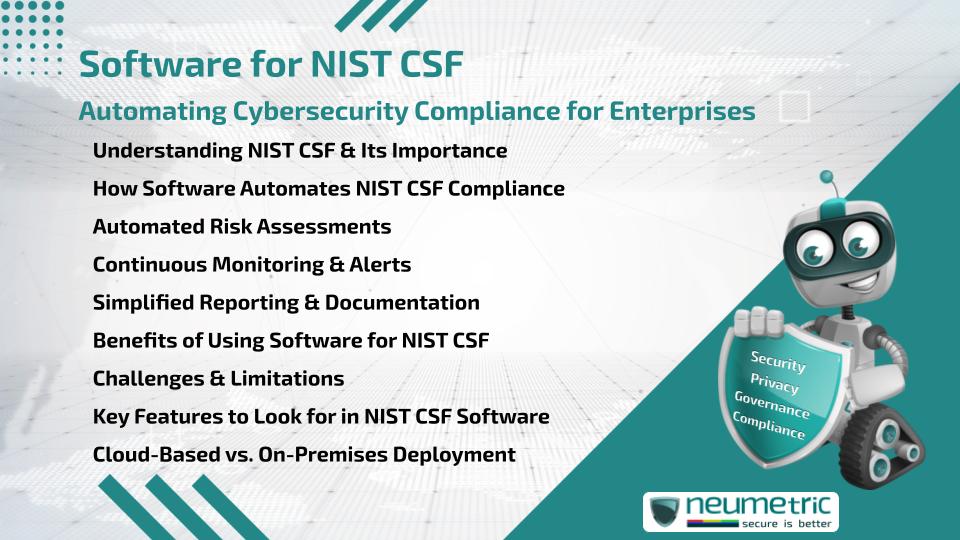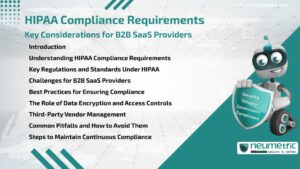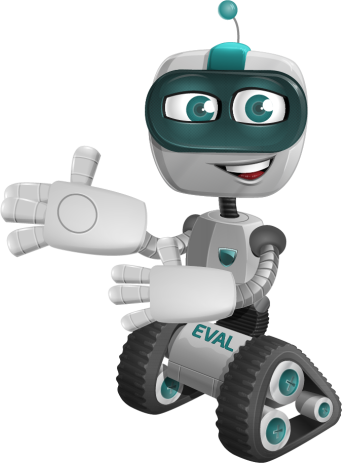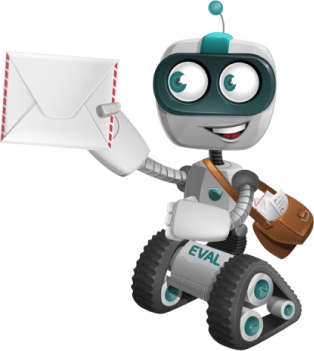Table of Contents
ToggleIntroduction
Cybersecurity threats continue to evolve, making compliance with established frameworks a necessity for enterprises. The National Institute of Standards & Technology Cybersecurity Framework [NIST CSF] provides structured guidance to manage cybersecurity risks. However, implementing this framework manually can be complex & time-consuming. This is where software for NIST CSF plays a crucial role by automating compliance, streamlining risk assessments, & ensuring continuous monitoring.
This article explores how software for NIST CSF simplifies compliance, the benefits & challenges of automation, & the key features enterprises should consider when selecting the right tool.
Understanding NIST CSF & Its Importance
NIST CSF is a voluntary framework designed to help organizations improve their cybersecurity posture. It consists of five core functions: Identify, Protect, Detect, Respond, & Recover. Each function contains categories & subcategories that guide organizations in developing a robust cybersecurity strategy.
Adopting software for NIST CSF allows enterprises to map their security controls efficiently, identify gaps, & automate reporting processes. By doing so, businesses reduce the risks associated with human error & ensure consistency in their cybersecurity approach.
How Software Automates NIST CSF Compliance
Automated Risk Assessments
Traditional risk assessments require manual evaluation of cybersecurity controls, which is both time-consuming & prone to errors. Software for NIST CSF automates this process by scanning networks, identifying vulnerabilities, & mapping them to the framework’s guidelines. This enables security teams to prioritize risks & take proactive measures.
Continuous Monitoring & Alerts
One of the key advantages of software for NIST CSF is its ability to provide real-time monitoring. By continuously tracking security events, these tools generate alerts for potential threats & compliance deviations. This ensures that organizations can respond quickly & maintain adherence to NIST CSF requirements.
Simplified Reporting & Documentation
Regulatory audits dem& detailed cybersecurity documentation. Manually compiling reports can be a daunting task. Software for NIST CSF simplifies this by generating automated reports that align with Compliance Standards. This not only saves time but also enhances transparency & accountability.
Benefits of Using Software for NIST CSF
Increased Efficiency
Automating compliance eliminates the need for manual tracking, allowing security teams to focus on critical threat mitigation. This leads to improved efficiency in managing cybersecurity risks.
Cost Savings
While implementing software for NIST CSF requires an initial investment, it reduces long-term costs associated with compliance audits, fines, & security breaches. Automated tools minimize resource allocation, making cybersecurity management more cost-effective.
Improved Accuracy & Consistency
Human errors in cybersecurity assessments can lead to compliance gaps. Software for NIST CSF ensures accurate data collection, analysis, & reporting, reducing inconsistencies in compliance efforts.
Scalability
As enterprises grow, their cybersecurity needs evolve. Automated tools offer scalability, allowing organizations to integrate additional security controls & exp& their compliance framework seamlessly.
Challenges & Limitations
Initial Setup Complexity
Deploying software for NIST CSF requires careful configuration to align with an organization’s existing cybersecurity infrastructure. This setup can be challenging without expert guidance.
Integration with Legacy Systems
Not all enterprises operate on modern IT infrastructure. Some organizations face difficulties integrating compliance software with outdated systems, requiring additional customization.
Dependence on Automation
While automation improves efficiency, over-reliance on software for NIST CSF can lead to reduced human oversight. Organizations must strike a balance between automated processes & expert-driven decision-making.
Key Features to Look for in NIST CSF Software
Customizable Risk Management Tools
The ability to tailor risk assessments to an organization’s specific needs enhances compliance accuracy. Look for software that allows customization of risk parameters & control mapping.
AI-Powered Threat Intelligence
Advanced software for NIST CSF solutions integrate artificial intelligence to analyze cybersecurity trends & predict potential threats, enabling proactive risk management.
User-Friendly Interface
A well-designed interface simplifies compliance management by making risk assessments, reporting, & monitoring accessible to security teams with varying levels of expertise.
Cloud-Based vs. On-Premises Deployment
Enterprises should consider whether cloud-based or on-premises deployment best suits their security requirements. Cloud-based solutions offer flexibility, while on-premises options provide greater control over data security.
Takeaways
- NIST CSF provides a structured approach to cybersecurity risk management.
- Software for NIST CSF automates compliance, improving efficiency & accuracy.
- Automated risk assessments, real-time monitoring, & reporting simplify adherence to the framework.
- Benefits include cost savings, scalability, & enhanced accuracy.
- Challenges include integration complexities & the need for human oversight.
- Choosing the right tool requires evaluating features such as AI capabilities, customization options, & deployment flexibility.
FAQ
How does software for NIST CSF improve compliance?
It automates risk assessments, monitors security events in real-time, & simplifies compliance reporting, reducing manual effort & errors.
Is software for NIST CSF suitable for small businesses?
Yes, many solutions offer scalable features that adapt to businesses of all sizes, making compliance management accessible for small enterprises.
Can NIST CSF software replace human cybersecurity teams?
No, while automation enhances efficiency, human oversight remains essential for interpreting insights & making critical security decisions.
What are the cost implications of implementing NIST CSF software?
The cost varies based on the solution’s features, deployment model, & enterprise size. However, long-term savings outweigh initial investment costs.
Does NIST CSF software work with other compliance frameworks?
Yes, many solutions support multiple frameworks such as ISO 27001, HIPAA, & GDPR, allowing organizations to manage broader compliance requirements.
What challenges do enterprises face when adopting NIST CSF software?
Challenges include integration with legacy systems, setup complexity, & ensuring a balance between automation & manual oversight.
How frequently should organizations update their NIST CSF compliance software?
Regular updates are necessary to adapt to evolving cybersecurity threats & maintain compliance with updated framework guidelines.
What is the difference between cloud-based & on-premises NIST CSF software?
Cloud-based solutions offer remote accessibility & flexibility, while on-premises software provides direct control over security infrastructure.





